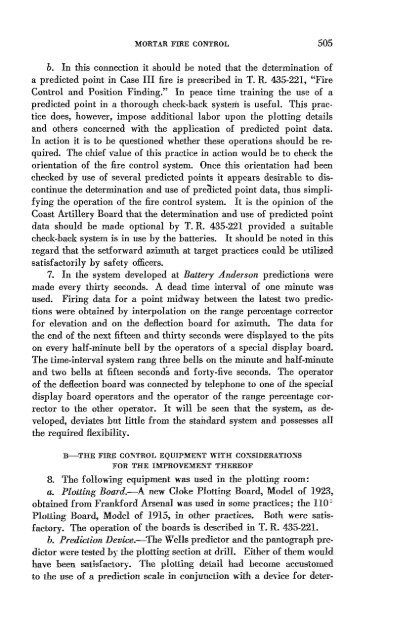COAST ARTILLERY, JOURNAL - Air Defense Artillery
COAST ARTILLERY, JOURNAL - Air Defense Artillery
COAST ARTILLERY, JOURNAL - Air Defense Artillery
You also want an ePaper? Increase the reach of your titles
YUMPU automatically turns print PDFs into web optimized ePapers that Google loves.
MORTAR FIRE CONTROL 505<br />
b. In this connection it should be noted that the determination of<br />
a predicted point in Case III fire is prescribed in T. R. 435-221, "Fire<br />
Control and Position Finding." In peace time training the use of a<br />
predicted point in a thorough check-back system is useful. This practice<br />
does, however, impose additional labor upon the plotting details<br />
and others concerned with the application of predicted point data.<br />
In action it is to be questioned whether these operations should be required.<br />
The chief value of this practice in action would be to check the<br />
orientation of the fire control system. Once this orientation had been<br />
checked by use of several predicted points it appears desirable to discontinue<br />
the determination and use of pred.icted point data, thus simplifying<br />
the operation of the fire control system. It is the opinion of the<br />
Coast <strong>Artillery</strong> Board that the determination and use of predicted point<br />
data should be made optional by T. R. 435-221 provided a suitable<br />
check-back system is in use by the batteries. It should be noted in this<br />
r.egard that the setforward azimuth at target practices could be utilized<br />
satisfactorily by safety officers.<br />
7. In the system developed at Battery Anderson predictions were<br />
made every thirty seconds. A dead time interval of one minute was<br />
used. Firing data for a point midway between the latest two predictions<br />
were obtained by interpolation on the range percentage corrector<br />
for elevation and on the deflection board for azimuth. The data for<br />
the end of the next fifteen and thirty seconds were displayed to the pits<br />
on every half-minute bell by the operators of a special display board.<br />
The time-interval system rang three bells on the minute and half-minute<br />
and two bells at fifteen seconds and forty-five seconds. The operator<br />
of the deflection board was connected by telephone to one of the special<br />
display board operators and the operator of the range percentage corrector<br />
to the other operator. It will be seen that the system, as developed,<br />
deviates hut little from the standard system and possesses all<br />
the required flexibility.<br />
B-THE FIRE CO!'iTROL EQUIPME!liT WITH COC\"SIDER...\TIO~S<br />
FOR THE IMPROVRME:"iT THEREOF<br />
8. The following equipment was used in the plotting room:<br />
a. Plotting Board.-A new Cloke Plotting Board, Model of 1923,<br />
obtained from Frankford Arsenal Yiasused in some practices; the lIO°<br />
Plotting Board, Model of 1915, in other practices. Both Yiere satisfactory.<br />
The operation of the boards is described in T. R. 435-221.<br />
b. Prediction Device.-The Wells predictor and the pantograph predictor<br />
were tested by the plotting section at drill. Either of them Yiould<br />
have been satisfactory. The plotting detail had become accustomed<br />
to the use of a prediction scale in conjunction with a device for deter-
















